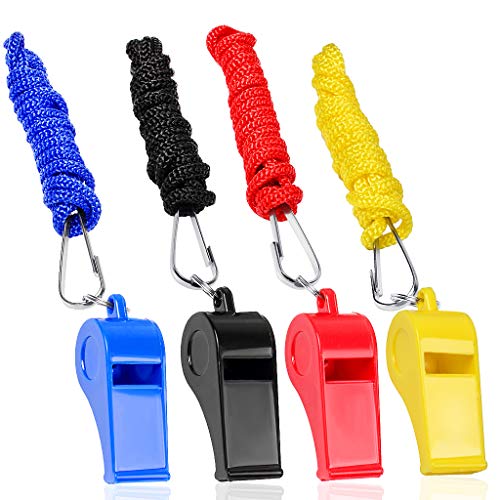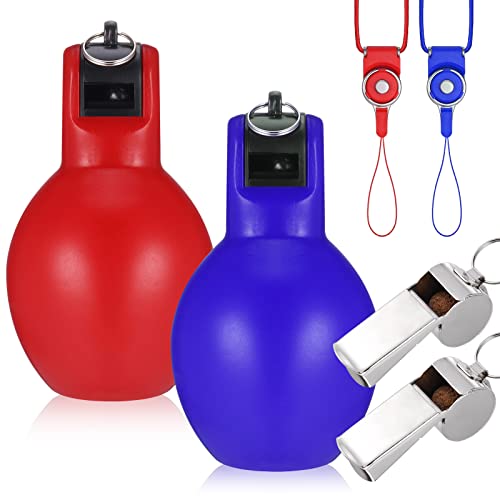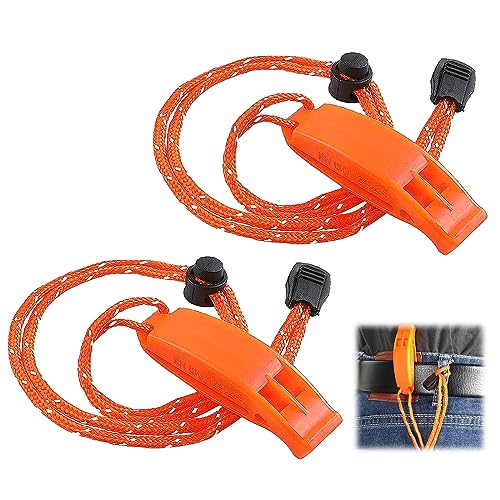
Introduction to Whistles
Whistles have a rich history, serving as simple yet powerful tools designed to emit a loud, attention-grabbing sound. Originating thousands of years ago, these devices have evolved significantly, finding their place in various fields including sports, safety, and self-defence.
The primary function of a whistle is to produce a clear and piercing sound that can be easily heard over distances, making it an essential tool in alarming situations.
In the realm of sports, referees and coaches have used whistles to signal game actions, ensuring a smooth flow during events.
Beyond sporting arenas, whistles have also played a crucial role in safety measures. For instance, lifeguards utilize whistles to communicate warnings or direct attention in potentially dangerous situations, while outdoor enthusiasts often carry them as a whistle distress signal during hiking or camping trips.
This simple yet effective tool becomes a lifeline when traditional methods of communication fail.
The significance of whistles extends into the concept of self-defence. Devices like whistles for self-defence can deter potential attackers, as the loud sound is likely to draw attention and alert others nearby.
Many safety enthusiasts and personal defence advocates promote the use of these devices, highlighting their effectiveness in various scenarios.
Additionally, the market for whistles has seen an increase in options available through whistles sales, allowing consumers to choose from a range of features tailored to their needs.
As we progress through this guide, we will explore the versatility of whistles and their implications in enhancing personal safety and awareness.
The simple act of blowing a whistle is more than just noise; it serves as a powerful means of communication and alertness, vital in maintaining safety in our daily lives.
Why Whistles are Effective for Alarming Situations
Whistles are an often-overlooked tool in personal safety and self-defence scenarios.
Their effectiveness in alarming situations can be attributed to several key factors, including sound projection, ease of use, and their ability to attract attention from significant distances.
Firstly, the sound projection of a whistle is unrivalled.
Unlike verbal calls for help, which can be muffled or inaudible in noisy environments, a whistle produces a high-pitched sound that carries over long distances.
This quality makes whistles for self-defence an invaluable asset for anyone concerned about their safety. In situations where an individual may find themselves in distress, using a whistle can generate a loud, piercing sound that can cut through ambient noise, thereby alerting those nearby of the situation.
Furthermore, whistles are incredibly easy to use, making them accessible to all individuals. They require minimal physical strength or dexterity.
In emergencies where panic can easily set in, the simplicity of blowing a whistle means that even under stress, a person can effectively communicate their need for assistance.
This ease of use contributes to their viability as a safety solution, allowing users to keep their focus on the situation at hand rather than on how to initiate a distress signal.
Another essential benefit of whistles is their ability to attract attention. Whether you are in a crowded area or a remote location, a whistle’s distinctive sound can reach the ears of those who might otherwise miss a voice calling for help.
This capability can be especially crucial during emergencies, such as outdoor activities or situations where individuals are isolated.
The effectiveness of a whistle in such contexts underscores its importance as a necessary tool for personal safety and self-defence.
By opting for a whistle, individuals are not only enhancing their preparedness for emergencies but also ensuring they have a reliable means of alerting others in distressing situations.
Types of Whistles and Their Features
Whistles have long been an essential tool for signalling distress or gaining attention. With many options available in today’s market, understanding the different types of whistles can aid in selecting the appropriate one for self-defence or safety.
The most common types include pea whistles, plastic whistles, and electronic whistles, each exhibiting unique features catering to various needs.
Pea whistles, often constructed from metal or plastic, contain a small ball or “pea” that rattles when the whistle is blown.
This design allows for a rich, loud sound, making them effective in an emergency. Their sound can carry over long distances, making them suitable for outdoor activities, such as hiking or camping.
While pea whistles are traditional and readily available, they require proper maintenance to ensure longevity, as moisture can affect their performance.
Plastic whistles, known for their durability and lightweight properties, offer a practical alternative to metal whistles. These whistles are often waterproof and less prone to corrosion, which can be advantageous in various environments.
Although some plastic models may lack the same resonance as pea whistles, their ability to produce a sharp sound remains invaluable in self-defence scenarios.
Due to their affordability, they frequently appear in whistle sales, appealing to both casual users and serious enthusiasts.
Electronic whistles represent the latest innovation in safety signalling.
These devices utilize batteries to emit loud, clear tones at the push of a button. The volume control and distinct sound frequency make electronic whistles particularly effective for individuals who may struggle with traditional options.
Designed with ease of use in mind, they often come equipped with features such as LED lights, further enhancing safety in low visibility situations.
Choosing the right whistle depends on personal preferences and specific use cases, whether for self-defence or recreation.
Familiarity with these various types of whistles ensures one can make a well-informed decision, enabling effective communication during critical moments.
Using a Whistle for Self-Defense
Whistles have long been recognized not just as signalling devices but also as effective tools for self-defence.
These compact instruments can serve as a whistle distress signal, alerting those nearby to a potentially dangerous situation.
When used strategically, a whistle can attract attention and deter potential threats. The key to effectively utilizing a whistle lies in understanding when and how to use it.
In self-defence scenarios, the first step is to remain calm and composed. Panicking can lead to indecision, making it crucial to recognize an opportunity to use the whistle.
If faced with an aggressive individual or an uncomfortable situation, using the whistle creates noise that can dissuade an attacker.
Carrying a whistle for self-defence not only provides a means of signalling for help but also instils confidence in the user, knowing they have a tool to call for assistance.
To create a loud sound with a whistle, ensure that it is of high quality, as a powerful whistle will be more effective.
Position the whistle correctly to maximize the sound; a firm grip with one hand while using the other to blow into the device can enhance volume.
It is recommended to practice using the whistle in various settings to familiarize oneself with its operation and to determine the best method for producing a distress signal.
Additionally, in moments of crisis, it is important to maintain control. Focus on your surroundings while using the whistle, raising it clearly to ensure the sound travels effectively in all directions.
Carrying whistles for self-defence, especially those small enough to attach to keychains, ensures they are readily available during emergencies.
By effectively preparing and practising enacting a whistle distress signal, individuals can enhance their personal safety and provide a means to seek help when truly needed.
How to Carry and Access Your Whistle
Effectively carrying a whistle can be the difference between safety and danger in emergency situations. Therefore, it is vital to choose a method that ensures quick accessibility. One popular option is to use a keychain whistle.
By attaching a small, compact whistle to your keys, you always have it within reach. This method guarantees that the whistle is easily identifiable and won’t be misplaced, making it perfect for self-defence scenarios.
Another practical solution is to consider a bracelet whistle. Designed for comfort and aesthetics, bracelet whistles come in various styles and materials, allowing individuals to wear them without apparent obstruction.
This option not only keeps the whistle readily available but also serves as a fashion accessory. In addition to being discreet, a bracelet whistle is always within arm’s length, ensuring it can be used swiftly if needed.
For those who frequently carry bags or backpacks, attaching a whistle to your bag can be a convenient choice. Look for a whistle that has a durable cord or clip, allowing for easy attachment to zippers or straps.
This method ensures your whistle remains visible and accessible when minutes count, making it an efficient addition to your self-defence toolkit.
Regardless of the method you choose, it’s important to consider visibility and ease of access in your everyday environment.
Whistles designed for self-defence should be integrated into your daily routine without much thought. Whether you are engaging in outdoor activities or navigating urban settings, keeping your whistle in a designated spot ensures you can react promptly in any emergency.
Therefore, evaluate your options and select the carrying method that aligns best with your lifestyle and accessibility needs.
Practical Situations to Use a Whistle
Whistles are versatile tools that can be invaluable in various practical situations, effectively serving as a whistle distress signal to attract attention and summon help.
One of the most common scenarios where a whistle proves essential is when individuals find themselves lost in the wilderness. In such instances, a loud whistle can travel much further than a human voice, making it easier for searchers to locate an individual in distress.
Reports have shown that many hikers and outdoor enthusiasts carried whistles for self-defence, leading to their successful rescue after getting lost or injured.
Another critical situation arises when encountering wildlife during outdoor activities. For instance, while trekking through nature, a loud, sharp whistle can be used to scare off potentially dangerous animals, such as bears or snakes.
In fact, many seasoned outdoorsmen advocate for the use of whistles as an immediate way to signal danger and deter wildlife from approaching, particularly in remote areas.
This use of a whistle not only promotes personal safety but also may help ensure the safety of those nearby.
In urban environments, whistles serve a different yet equally vital purpose. Individuals witnessing a crime or an emergency situation can use a whistle as a form of alert.
The piercing sound of a whistle can draw the attention of bystanders and deter the perpetrator, potentially preventing further harm.
Instances of people effectively using whistles during emergencies highlight the importance of always having one on hand.
With an array of options available in the whistle sale market, selecting the right whistle tailored for specific situations can significantly enhance personal safety measures.
Overall, whether in the great outdoors or in urban settings, having a whistle accessible can make a substantial difference in emergencies, ensuring that individuals can effectively communicate their need for assistance.
Whistle Etiquette: When and How to Blow
The use of a whistle as a distress signal is one of the simplest yet most effective methods of ensuring personal safety, particularly in emergency situations.
However, it is essential to understand the etiquette surrounding its use to maximize its effectiveness while minimizing unnecessary alarm.
Whistles for self-defence can be an invaluable tool, but improper use can lead to panic or confusion.
When blowing a whistle, it is important to consider both the duration and frequency of your blows. Short bursts are typically recommended; a series of three quick blows is widely recognized as a universal distress signal.
This pattern not only conveys urgency but is also distinct enough to capture attention without inducing panic. Prolonged whistles or erratic blowing may be misinterpreted, leading to confusion among bystanders or emergency responders.
In public settings, discretion and situational awareness are paramount. Before using your whistle, assess the environment to determine whether it is appropriate.
If you feel threatened or in danger, a whistle can serve as a vital alert to others nearby, calling for help without escalating the situation.
However, in crowded areas or large gatherings, excessive blowing may incite unnecessary alarm and could lead to unintended consequences.
It is also crucial to consider the context in which a whistle is used. In non-emergency situations, such as social gatherings or festivals, using a whistle can disrupt the atmosphere and negatively affect others.
Therefore, understanding the implications of your actions is key to adhering to whistle etiquette. Responsible use ensures that when a whistle is truly needed, it maintains its integrity as a distress signal.
Awareness of these etiquette guidelines is essential for anyone considering participating in whistle sales, whether for personal use or gifting purposes.
Ultimately, using a whistle correctly contributes to the safety of both the individual and the community.
Maintaining Your Whistle
Regular maintenance is crucial to ensure that your whistle functions optimally during emergencies. A whistle distress signal can be a life-saving tool, but its effectiveness is compromised if not properly maintained.
First and foremost, it is important to clean your whistle regularly. Over time, dirt, moisture, and other debris can accumulate inside the whistle, affecting its sound quality.
Cleaning can be done by rinsing your whistle under warm water and using mild soap, followed by thorough drying. This prevents the growth of mould and preserves the internal mechanism.
In addition to cleaning, testing the sound of your whistle should be done periodically. This not only ensures that the whistle is operational but also helps you become familiar with the sound it produces.
Familiarity is essential, especially in high-stress situations when clear and effective signalling is necessary. A well-maintained whistle typically produces a high-pitched, penetrating sound that can carry great distances, making it suitable for self-defence situations or signalling for help.
Another important aspect of maintenance is inspection for any physical damage. Regularly check for cracks or defects that could impair the whistle’s functionality.
If you notice any issues, consider replacing it. When shopping for new options, look for quality whistles suitable for self-defence and personal safety.
Whistles for self-defence that are durable and reliable are available on the market. Additionally, keep abreast of whistle sale announcements, as many retailers offer discounts that can help on purchasing multiple whistles, ensuring you are prepared for any situation.
In conclusion, the maintenance of your whistle is vital in ensuring it is always ready to perform when needed. Through regular cleaning, sound testing, and inspection for wear, your whistle can remain an indispensable part of your safety toolkit.
Conclusion: The Importance of Being Prepared
As we have explored throughout this blog post, the power of whistles extends far beyond their seemingly simple design.
Whistles serve as crucial tools for safety and self-defence, offering individuals an effective means of communication in distressing situations.
The versatility of whistles allows them to be utilized in various environments, including outdoor adventures, urban settings, and emergency scenarios. Their audible signal can not only alert others to an emergency but can also deter potential threats when used as a whistle distress signal.
In today’s world, personal safety is paramount, and equipping oneself with the right tools can make a significant difference. Whistles for self-defence are lightweight, portable, and economical, making them accessible to a wide audience. With the growing availability of whistles for sale in various styles and designs, it is easier than ever to find an option that fits an individual’s needs.
Carrying a whistle can be a proactive measure that ensures one is prepared should an emergency arise. The sound produced by a whistle is loud enough to be heard over considerable distances, which could attract attention and lead to timely assistance.
Moreover, the psychological benefits of carrying a whistle cannot be underestimated; knowing you have a device that can draw attention in critical moments can enhance your overall sense of security.
In conclusion, investing in a whistle as part of your self-defence strategy represents a simple yet effective decision.
By prioritizing preparation and ensuring that you have a whistle readily available, you can significantly improve your ability to respond to unexpected situations, thereby enhancing your personal safety and peace of mind.
We would love to if you have ever used a whistle to avoid danger, feel free to comment below.

































